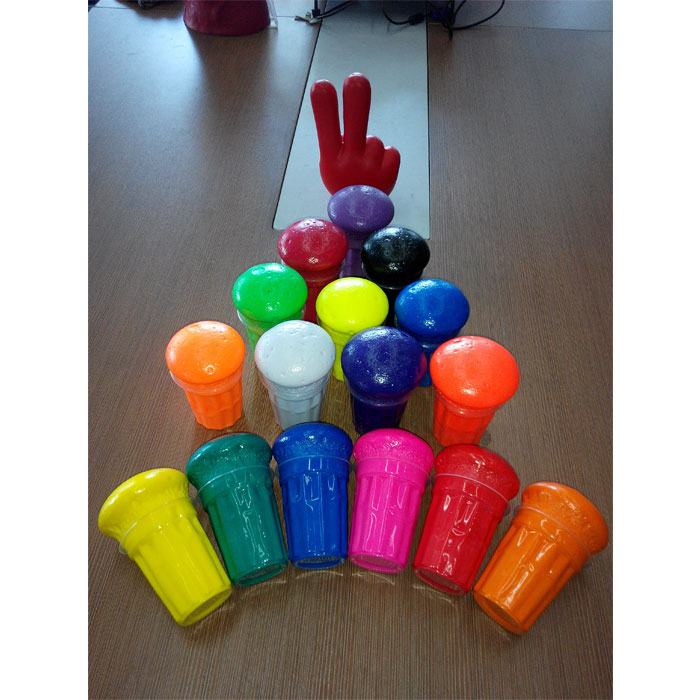Polyurethane elastomer formed by the polymerization reaction of diisocyanate and active hydrogen compound, the rigid segment containing urea group composed of diisocyanate and diamine chain extender, the glass transition temperature is much higher than room temperature, and it is glassy at room temperature. Subcrystals or microcrystals form the plastic phase; flexible segments of polyether or polyester are gathered together to form the matrix or matrix of the polyurethane rubber. Because its glass transition temperature is lower than room temperature, it is called the rubber phase. The microphase separation of the polyurethane elastomer makes the polyurethane elastomer have the advantages of good wear resistance, wide range of hardness, high strength and high elongation, large load supporting capacity, good shock absorption effect and excellent oil resistance. Choosing a suitable molding and processing method can maximize the performance of polyurethane elastomers and prepare various polyurethane elastomers with excellent properties, which are widely used as plastics, rubber, fibers, adhesives and coatings, and even as functional polymer materials. Such as medical polyurethane materials.
1.1 General principles for selecting forming processing methods
(1) Molding processing is usually to melt or deform a polymer compound in a solid state (powder or granular), paste or solution state, and form the desired shape through a mold, and maintain the shape that has been obtained, and finally obtain the product. crafting process.
(2) Common molding processing flow: ①The method of forming the polymer compound mixture once and twice to produce products; ②The method of forming the polymer compound to produce products at one time; ③The method of producing products from the monomer mixture in one step ④ One-step production method of oligomer mixture.
(3) Processing performance and its influencing factors: ①Squeezability, in the extruder, the barrel of the injection machine, the rollers of the calender, and the mold, when the material is deformed by extrusion, the shape of the material is obtained and maintained ability. Its restrictive factors: melt viscosity, processing equipment structure, melt rheology and melt flow rate. ②Moldability, in the molding process under the action of injection machine, extruder, and compression machine, the material is deformed under the action of temperature and pressure and the ability to be molded in the mold. Its restrictive factors: rheology, thermal properties and other physical and mechanical properties and chemical reactivity of polymer compounds. ③Extensibility, in calendering or stretching, the material is deformed by calendering or stretching in one or two directions. Its restrictive factors: the plasticity of the material and the strain hardening effect. ④ Spinnability, the nozzle during extrusion molding, the ability of the material to form continuous solid fibers through molding. Its restrictive factors: rheology, melt viscosity and strength, thermal stability and chemical stability.
1.2 General principles for selecting molding and processing methods for polyurethane elastomers
Polyurethane elastomer molding processing system is divided into liquid system and solid system. On the basis of the rapid polymerization reaction of diisocyanate and active hydrogen compound, the molding processing method is conducive to the microphase separation of the polyurethane elastomer. , Liquid system, polyurethane casting glue can be processed by casting (manual casting, centrifugal casting and vacuum casting), reaction injection molding, spraying, knife coating, roller coating, laminating, laminating, bonding, vulcanizing, pasting and rubbing ; Solid system, polyurethane compound rubber can be vulcanized and laminated with mold, polyurethane thermoplastic can be used with thermoplastic, hot injection, calendering, blow molding, spinning and lamination.
1.3 The matching principle of basic types and molding processing methods
Polyurethane elastomer is a high polymer between plastic and rubber in terms of its modulus. It mainly includes polyurethane compound rubber, polyurethane cast rubber, polyurethane water emulsion and polyurethane thermoplastic. Polyurethane leather, polyurethane adhesives, polyurethane coatings, polyurethane compounds, polyurethane casting glues, polyurethane fibers, polyurethane water emulsions and polyurethane thermoplastics are all derived from the above four types of glue. The molding and processing methods of polyurethane compound rubber, polyurethane water emulsion and polyurethane thermoplastic generally belong to the molding processing methods of rubber, coatings and plastics.
1.4 The use of polyurethane elastomers and the matching principle of production continuity and molding processing methods
Polyurethane elastomer molding and processing methods are matched with the use of polyurethane elastomers, taking into account the continuity of production. For example, polyurethane leather molding methods usually use polyurethane casting adhesive or foaming layer, polyurethane water emulsion and polyurethane thermoplastic as the surface layer; also available Polyurethane thermoplastic and polyurethane water emulsion are used as leather separately, which are based on the basic rubber molding processing method, supplemented by foam molding processing, usually calender molding processing method is selected. Polyurethane paving materials are made of polyurethane casting glue, mainly due to the large product shape and low precision requirements. Medical polyurethane materials have good chemical stability, tissue compatibility, and resistance to biological aging, so the molding process uses dip coating, pouring and coating methods.


